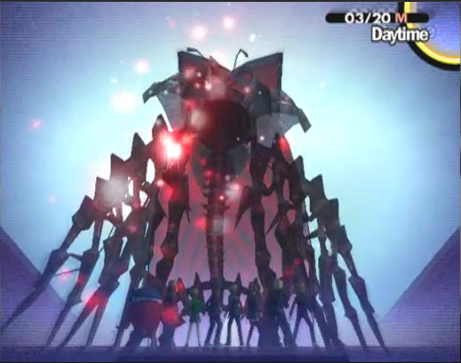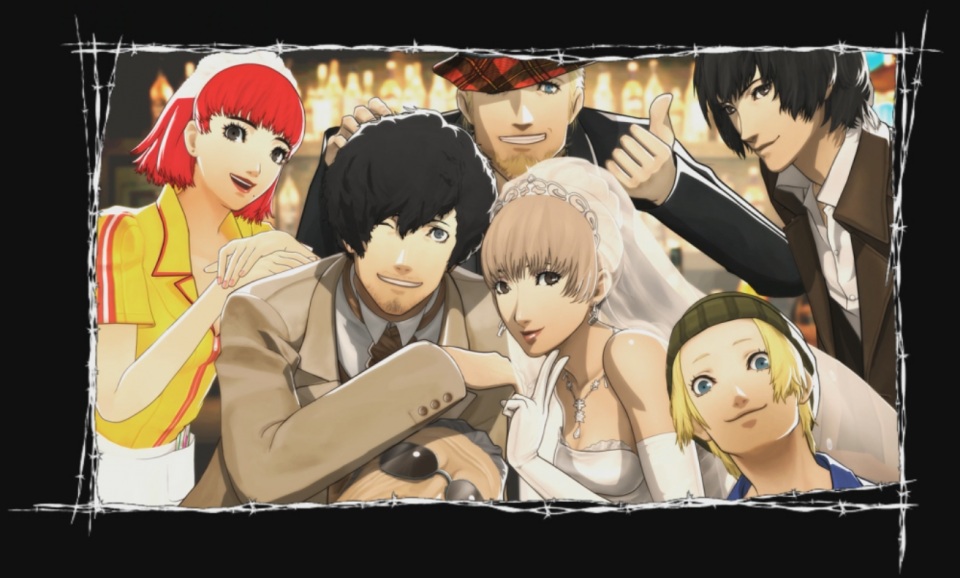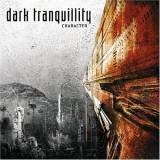marlow83's forum posts
To your first assertion, I say we are suggesting roughly the same thing, but in two different ways (I mention Vincent's temptations). To the second, I say whoops, my badThe Immoral Beast is not representative of Catherine's desires, they're representative of Vincent's (natural) perversions.
edit: Chie's boss had strong male imagery and sat on top of a throne of enslaved girls. Chie doesn't feel that she comes off as naturally feminine and has control issues regarding Yukiko.
You have truly read my article and put deep thought into this response. I thank you for the insightTHE ONLY GAME ATLUS HAS EVER MADE IS PERSONA 4... ENDURANCE RUN! BUFU! STEAK!
If you were to ask most people to name ways that Catherine andPersona 4 are alike, I can guarantee they’d name aspects like the anime style, the animated cutscenes, the voice cast, the supernatural, the developer, etc. But beyond the more superficial elements, I would submit that Persona 4 and Catherine are very similar games. They tell their story in similar ways, the trials a few of the characters undergo parallel each other, and they share some themes and ideas. I don’t mean to belittle either game by stating that they both share themes and explore similar topics, but I do think that looking at these games from this point of view may reveal a little about Atlus, and how that studio crafts its tales.
I’ll start with the most obvious and overt similarity in the two game’s storytelling style (that I didn’t mention above), the use of rumors and eavesdropping as a way to convey information to the player, and as a way for the main characters to learn more about their situation. Let’s start with Persona 4’s Midnight Channel and Catherine’s Dreams. The Midnight channel is introduced by Chie Satonaka, who tells everyone of the rumor that when it rains, a person can see their soulmate appear on a TV screen at midnight. As we all know, being told this prompts the main character to watch TV at midnight and “confirm” the rumor, with the addenedum that he can enter the television. The role of Chie is essentially played by Erica in Catherine, who makes it her business to inform the 4 main characters of every rumor she hears about, from the “dream where you’re falling,” to the witch, to the “Woman’s Wrath.” Also, the characters from Persona 4 and from Catherine listen to other peoples’ conversations regularly, such as when the main character from P4 hears two girls talking about seein Inaba get absorbed by fog on the midnight channel, or when Vincent hears two people discuss the death of Steve the dentist.
What effect does this have on the story? Well, it’s a fairly reasonable way for the characters to gain information that drives the plot forward. It also presents the idea the plot affects more people than just the main characters: the fatal and/or catastrophic world ending events have caught the attention of more than a few people. Interacting with all the sheep that have been marked for death in Catherine makes the rumors unnecessary an maybe a tad redundant in this regard, but it still does show that people are taking notice of the strange goings on. I really don’t have anything witty or sharp to say regarding this, it is merely a noticeable similarity, that both games rely on this method of storytelling to further their respective plot. Some might argue that it is a narrative crutch, but I wouldn’t say so. The rumors in both games are never 100 % accurate as to what is actually happening, and it is reasonable that rumors would spread when weird events such as those in both games occur. In fact, it is worth noting that the rumors and stories in Catherineare almost all red herrings. While this makes the inclusion of rumors like the “witch” rather irritating, it is believable that they would develop in the game’s reality.
Another obvious presence in Catherine and Persona 4 are the overtly symbolic bosses. In Persona 4 we are treated to Shadow Yukiko, who transforms into a bird escaping its cage, symbolizing her desire to break free of the town she has spent her entire life in. We see Shadow Kanji, who transforms into a chisled guy holding two symbols for men, which represents Kanji’s repressed homosexuality. Shadow Rise transforms into a monster/stripper thing, which represents her desire to ‘reveal’ her true personality, and abandon the persona (teehee) of Risette. And finally we have Shadow Namatame, who changes into an odd looking interpretation of Christ, which represents how he sees himself: he believes that he was rescuing the people he nearly killed. In Catherine, the majority of the bosses were symbols as well, including the giant baby, who represented Vincent’s fear of parenthood, a monster version of Katherine in a wedding dress, which symbolizes Vincent’s fear of marriage, and a monster that has a gaping mouth where its vagina should be, representing the sexual desires of Catherine, and how they tempt Vincent. Now, these symbols are certainly stronger in one game (coughpersona4cough) than they are in the other, but they all hold the same occupation in the story: to introduce or influence understanding of an issue a character has, be it Vincent’s fear of parenthood or Kanji’s sexuality. Seeing these physical manifestations of purely emotional sentiments does reveal things about that character, even if it is as minor as revealing the severity of their worries. And even though the symbolic bosses in Catherine are not as clever as they are in Persona 4, they all make sense when taken in context, since they all exist within Vincent’s mind, and the mind does not create some kind of subtle image in dreams when a person is afraid of something. I’m afraid of spiders, and I have nightmares about big motherfucking spiders. And for what its worth, neither game is perfect when it comes to clever/symbolic boss design, and as proof I tell you this: Banana head Chie and Child with Chainsaw. What the fuck.
It is also worth mentioning that the people that Vincent interacts with at the Stray Sheep bar in Catherine are essentially the Social Links fromPersona 4, just on a smaller scale, if you will. First and foremost, they are structured in the same way. A person has a problem, they talk to the main character about that problem, and then they overcome that problem thanks to moral support from that main character, and because they just needed to explain their issue to anyone who would listen. In both games, these interactions aren’t very deep, with either main character only stopping to interject on occassion, and only having two or three options of what to say. Often, these dialog options have no real impact on the conversation as a whole, or the way the supporting character’s story plays out. The gameplay is more of a matter of time management, since the player has to decide who he interacts with and when as time passes in both games. Regardless, these interactions are all fairly believable and satisfying. In Persona 4, all of the characters are kids, and they issues that kids deal with. As such, the simple act of opening up to someone they trust is enough for them to come to terms with their respective issue. In Catherine, the issues people deal with are much darker, and they actually do deal with their delimmas in a different fashion. They all do open up to Vincent, and Vincent offers condolences or whatever. But the interactions in the real world are not where the triumphs of the bar patrons occur. Using Vincent’s climbing as their example, they overcome the threat of an actual, physical death. These victories are what make the attendees of the Stray Sheep realize that their lives are not as meaningless as they thought. When faced with the possibility of death, they realize, through fear or courage, that they do want to live and that they need to put the past behind them in order to move on. What is excellent about both the Social Links and the bar patrons is that the characters do not use the protagonist as a crutch, but they find their own strength within themselves. hey just needed a little help.

Perhaps the most important, most significant area where the two games parallel one another is in their central theme: The unmatched strength of the human spirit. In both Persona 4 and Catherine, we are shown average human beings overcoming Gods: Izanami in Persona, and Dumazid in Catherine. Izanami is the force behind the midnight channel, whose actions are explained in this monologue:
“Everything was for your sake… to create the world mankind so wanted. Man struggles to understand one another. You can only truly know a finite number of people within your lifetime. But humans disregard this fact and try to know more people than is possible. Only by comparing yourself to others can you define yourselves. Thus your ever-present anxiety. Your anxiety causes you to see only what you want to see, and believe only what you wish to believe. As I said, your desire is for a world enshrouded in fog!”
Essentially, what Izanami is saying is that she created the midnight channel so humanity could learn about those they were interested in but would never get the opportunity to meet (people who appeared on television in the real world). In fact, the TV world is a creation of the people of Inaba, who have collectively created an ideal world. But, according to Izanami, in turn eith that desire, people only want to see what they believe, and nothing that would confuse or challenge them. Therefore , Izanami made the TV world be shrouded in fog, and attempts to consume the real world in fog as well.
Anywho, after fighting Izanami, we are treated to this incredibly intelligent discussion between Izanami and two of the more outspoken protagonists:
IZANAMI: “Instead of the endless struggle, wouldn’t it be easier to wrap oneself in lies and live in blissful ignorance? Isn’t that true peace for humans?”
KANJI: “The hell with that shit!”
CHIE: “Stop assuming you know us!”
While Chie and Kanji prove that they are not masters of the English (Japanese?) language here, they get their point across well enough. This deity has misconstrued the desires and motivations of humans. They do not desire to live in a world where they are blind and ignorant. They will face life without a veil, regardless of how difficult it is. But perhaps Izanami herself sums it up best:
”Power enough to erase my existence. You have already exceeded what I thought humanity to be capable of…”
Boom. A few teenage kids have overcome the will of a god.

A scenario that is fairly analogous to this occurs in Catherine as well. After enduring 9 nights of climbing for his life, the all-too-average Vincent manages to overcome the tests set forth by a being of Godly power, Dumazid (aka Boss aka Thomas Mutton). Dumazid’s stated agenda is similar to that of Izanami, in that he believes what he is doing, murdering men who are too weak to commit to their loved ones and ensure the continued existence of the human race, is for the best. After overcoming the trials Dumazid/ set forth, impressing even Astaroth (a being that has more power/has been around longer than Thomas Mutton has), Vincent also gives a less than impressive speech, in which he states that “men and women are more complicated than you think,” and that they don’t need to be “herded.” Again, the protagonist does at least succeed in making their point. The Godly have shown a lack of understanding of how the human race operates, and they force humanity to suffer through it. Vincent is able to overcome the challenges presented by the opposing deity, showing the strength of humanity, then is able to articulate in what way the God he faces does not, to quote Francis Zach Morgan, “understand humans.”
Now, there are some serious differences between these games (in ways other than the core narrative). For example, Catherine explores religious themes and shows religious imagery that is not found in Persona 4. Vincent actually takes on a certain Christ role, but not in the traditional ‘died for our sins’ sense. He becomes a leader, an almost literal shepherd, as he leads a flock of sheep (the other men having the nightmares) to safety. He is a normal man who inspires faith and encourages those who follow him and his teachings (read: techniques). Actually, another interpretation of the sheep is a statement regarding the way we perceive ourselves versus the way we see the rest of humanity. In the nightmares, every person can only see themselves as human, and every other person present appears as a sheep. This could represent the way humans see ourselves: we believe that we are truly unique and original, while everyone else is a mere sheep, part of a crowd, and utterly indistinguishable. We have to realize that these automatons we think we’re surrounded with are people just like us, and doing so will make us stronger as a whole, just as the sheep in Catherine realized that being selfish wasn’t the way to survive.
There is also a massive difference in the tone of the two games, that is largely due to the age difference of the characters. The Persona group are flawed and tough, to be sure, but they are still just kids. They hang out and have fun, they say and do stupid things, and they approach a good few of the situations they face with a certain lightheartedness. There’s a certain childlike bravado to all of their rescue missions, a naive ‘fuck yeah’ attitude to their trips into the midnight channel, which is only shattered when Nanako is kidnapped. For the most part, Catherine lacks that same sort of brightness. The characters are older and decidedly more serious, and the game just lacks the silliness that permeated Persona 4. There is no school camping trip, nor are there hijinks in the Amagi Inn. That isn’t to say that Catherine is devoid of humor, the game is actually quite funny when it wants to be. But the humor is more based on clever quips during conversations, rather than ridiculous situations. But that’s beside the point. The characters inCatherine are darker and more mature than those in Persona 4, simply because they are (for the most part) adults dealing with adult issues. And actually, maturity is the source of all of the main characters’ issues. Vincent is afraid of fully maturing. Orlando faced maturity by marrying his wife, and suffered for it when she left him. Jonny seems like the kind of guy who tried to become an adult when he was 13. All in all, the characters have understandable, justified angst (I fucking hate that word) that contributes to the darker tone. As I stated above, the other people Vincent interacts are also working through much more serious issues than the P4 characters. A lot of these are normal scenarios for this sort of story (an abusive father, a murdered loved one), but Archie’s relationship with his mother is something that most games wouldn’t dare touch with a ten foot pole.
But in the end, Persona 4 and Catherine are very similar games when it comes to their themes and storytelling style. But is that a bad thing? I say no. Really, Catherine feels like a progression of Persona 4: Personadeals with the teeange years and the struggles that people go through then. Catherine takes the ideas of self discovery ans strength and applies them to adults. Ina strange way, Toby feels like the connective tissue between Persona and Catherine. He has found his identity, but has not truly had to deal with growing up and maturing. Honestly, I could imagine Yosuke being a lot like Toby 5 years after P4’s conclusion (both are voiced by Yuri Lowenthal). But even if you don’t buy that justification for the similarities, consider this: We celebrate Hemingway, even though his books seem to only tell stories about war-time love. But his stories are different enouh each time to catch the reader’s interest. Can we not celebrate Atlus in the same way?

Y'know, I could sit here and make an intelligent rebuttal to every single one of yahtzee's points, but nobody will read it and no one will care. So instead, I'll offer this piece of insight:
Yahtzee's a cunt.

Log in to comment